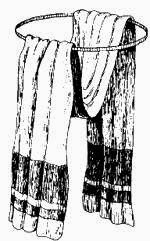Breechcloth
Breechcloth is worn by men and is a long rectangular piece of animal skin that is worn between the legs and tucked over a belt. They are also worn by women but not as outerwear. Wearing a breechcloth leaves the legs bare so leggings are worn. The leggings are attached to the same belt as the breechcloth. Native American womens leggings were shorter and not attached to the belt with the breechcloth.
http://www.native-languages.org/breechcloth.htm
As I said the styles and customs vary but in some tribes women wore a one piece dress. Like the one in the picture.
Moccasins and Mukluk
Most Native Americans wore moccasins, a leather shoe, or mukluk, sturdy leather boots. Again the styles vary but the basic material, leather, is common in all. Some are fringed others are decorated intricately.
Cloaks
Cloaks were worn in colder weather and many of the tribes in the northern parts of America wore fur parkas in the winter.
http://vivifypicture.com/native-american-wedding-dress
After the colonization of North America Native American tribes were pushed out of their land and forced to live more closely to each other. This resulted in many tribes sharing their tribal dress between themselves.
Headresses and fringed garments became more popular in different tribes where they had not originated. Native Americans then started to bring in some more contemporary European styles to their clothing.
Today traditional clothing is only worn to religious ceremonies or other important events. Although items like moccasins are still wor on a daily basis in many tribes.
From this it is clear that the style of dress has to suit where you are living and in the case of the Native Americans it also depends on the materials that were available from the land to make their clothes. Also the fact that they moved closer together meant their clothing was shared and styles were adopted by each tribe.
Sources: http://www.native-languages.org/clothing.htm
http://www.warpaths2peacepipes.com/native-american-clothing/









